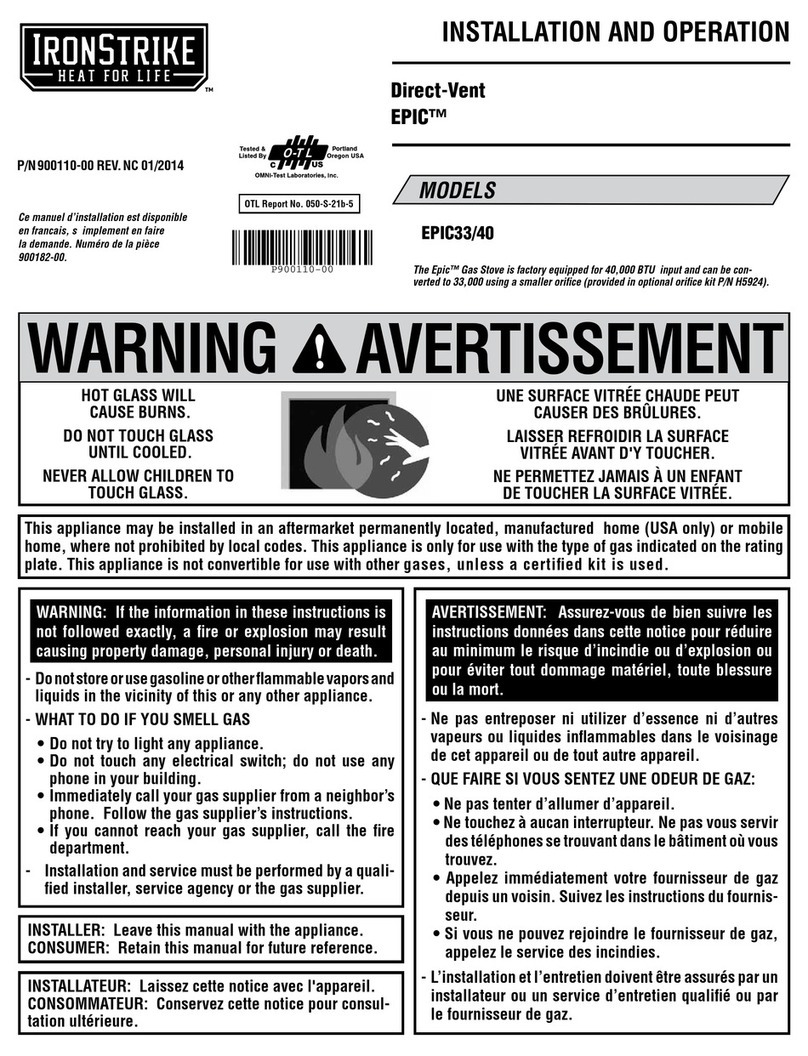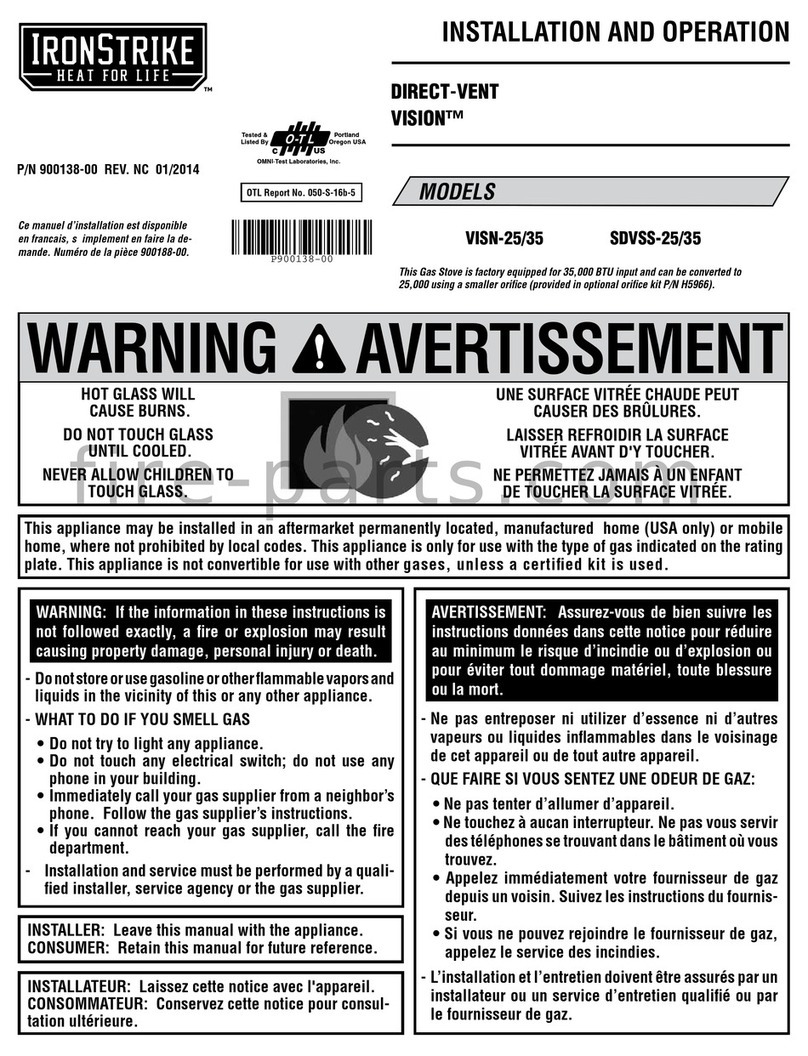
5
APPOSITION DES MISES EN GARDE RELATIVES
Il est impératif que les étiquettes de sécurité fournies
avec le foyer soient collées à côté des dispositifs
de contrôle du foyer. Une étiquette de sécurité doit
être collée sur la plaque de l’interrupteur contrôlant
l’allumagedufoyer(voir FigureA)ousurlethermostat
mural (voir Figure B)et, le cas échéant, sur le boîtier
de la télécommande (Figure C). Les mises en garde
auraientdûêtrecolléesaumomentdel’installationinitiale
du foyer. Si ce n’est pas le cas, prenez les étiquettes
adhésives multilingues fournies avec ces instructions
et procédez comme suit:
1. Repérez l’interrupteur ou le thermostat mural
qui contrôle le foyer (vérifiez que l’interrupteur
contrôle le fonctionnement du foyer en le faisant
basculerde MarcheàArrêt, etvice-versa). Nettoyez
soigneusement la plaque murale de l’interrupteur
ou le thermostat mural pour éliminer la poussière
et les traces de graisse ou d’huile. Collez l’étiquette
sur la surface de la plaque de l’interrupteur mural
qui contrôle le foyer (Figure A)ou du thermostat
mural (Figure B). Choisissez la langue qui est
principalement parlée dans la résidence du
propriétaire. En cas de doute, collez l’étiquette en
anglais.
2. Si une télécommande est utilisée pour contrôler
le foyer, nettoyez la soigneusement pour éliminer
la poussière et les traces de graisse ou d’huile.
Collez l’étiquette sur le boîtier de la télécommande
(Figure C). Choisissez la langue qui est principale-
ment parlée dans la résidence du propriétaire. En
cas de doute, collez l’étiquette en anglais.
3. Si vous ne trouvez pas les étiquettes, veuillez
appeler IHP ou votre distributeur IHP local pour
recevoirgratuitementdesétiquettessupplémentaires.
Étiquettes de remplacement, n° cat. H8024
IHP
www.IronStrike.us.com
Remarque : Le texte anglais est rouge sur un support
transparent. Le texte français et espagnol est blanc
sur un support noir.
COLOCACIóNDE ADVERTENCIASDESEGURIDAD
EN OPERACIóN
Se requiere que las etiquetas de instrucciones de
seguridad incluidas con la chimenea se coloquen en
el punto de operación y control de la misma. Se debe
colocar una etiqueta de instrucciones de seguridad
en la placa del interruptor de pared desde el cual se
enciende y se apaga la chimenea (ver la Figura A)o
en el termostato de pared (ver la Figura B)y en el
transmisor de control remoto (Figura C)si se usa.
Las advertencias ya deben haberse colocado cuando
se completó la instalación inicial de la chimenea. Si
no están colocadas en estos lugares, encuentre las
etiquetas adhesivas multilingües proporcionadas con
estas instrucciones y prosiga de la siguiente manera:
1. Identifique el interruptor o el termostato de pared
quecontrolalachimenea(verifiquequeelinterruptor
opera la chimenea encendiéndola y apagándola).
Limpiebienlaplacadelinterruptoroeltermostatode
pared para quitar el polvo y aceite. Pegue la etiqueta
enlasuperficiedelaplacadelinterruptorquecontrola
la chimenea (Figura A)o en el termostato de pared
(Figura B).Seleccione el idioma que más se habla
en la casa. Si no sabe cuál es, use la etiqueta en
inglés.
2. Si se usa un control remoto para controlar la
chimenea, encuentre el transmisor y límpielo bien
para quitar el polvo y aceite. Pegue la etiqueta en
la superficie del transmisor (Figura C).Seleccione
el idioma que más se habla en la casa. Si no sabe
cuál es, use la etiqueta en inglés.
3. Si nopuede encontrarlas etiquetas,sírvase llamara
IHPo aldistribuidordeIHPmáscercanopararecibir
etiquetasde instruccionesde seguridadadicionales
gratuitas.
Juego de etiquetas de repuesto - Nº de cat. H8024
IHP
www.IronStrike.us.com
Nota: La etiqueta en inglés es transparente con texto
rojo. Las etiquetas en francés y español son negras
con texto blanco.
ATTACHING SAFETY IN OPERATION WARNINGS
It is required that the safety instruction labels fur-
nished with the fireplace be affixed to the operation
andcontrolpointofthefireplace. Asafetyinstruction
label must be affixed to the wall switch plate where
the fireplace is turned on and off (See Figure A)or
wall thermostat (See Figure B)and if used on the
remote control handheld transmitter (Figure C).
The warnings should already have been put in place
when the fireplace initial set-up was completed.
If they are not affixed at these spots, locate the
multi-lingual adhesive labels provided with these
instructions and proceed as follows:
1. Locate the wall switch or wall thermostat that
controlsthefireplace (verifythe switch operates
the fireplace by turning it on and off). Clean the
wall switch plate or wall thermostat thoroughly
to remove any dust and oils. Affix the label to
the surface of the plate of the wall switch that
controls the fireplace (Figure A)or the wall
thermostat (Figure B). Choose the language
primarily spoken in the home. If unknown, affix
the English language label.
2. Ifaremotecontrolisusedtocontrolthefireplace,
locate the transmitter and clean it thoroughly
to remove any dust and oils. Affix the label to
the surface of handheld transmitter (Figure C).
Choose the language primarily spoken in the
home. If unknown, affix the English language
label.
3. If you are unable to locate the labels, please
contactIHP oryour nearestIHP dealertoreceive
additionalsafetyinstructionlabelsfreeofcharge.
Cat. No. H8024 Replacement Label Kit
IHP
www.IronStrike.us.com
NOTE: English is red text on clear label. French
and Spanish are white text on black label.
ATTACHING SAFETY-IN-OPERATION WARNING LABELS
SAFETY LABEL
DIAGRAMS
DIAGRAMAS DE ETIQUETAS
DE SEGURIDAD
DIAGRAMMES DES ÉTIQUETTES
DE SÉCURITÉ
Figure A Figure B Figure C
Illustrations are for example only.
Your accessories may be different.
Les illustrations sont par exemple
uniquement. Vos accessoires
peuvent être différents.
Las ilustraciones son sólo ejemplos.
Tu accesorios pueden ser diferentes.






























